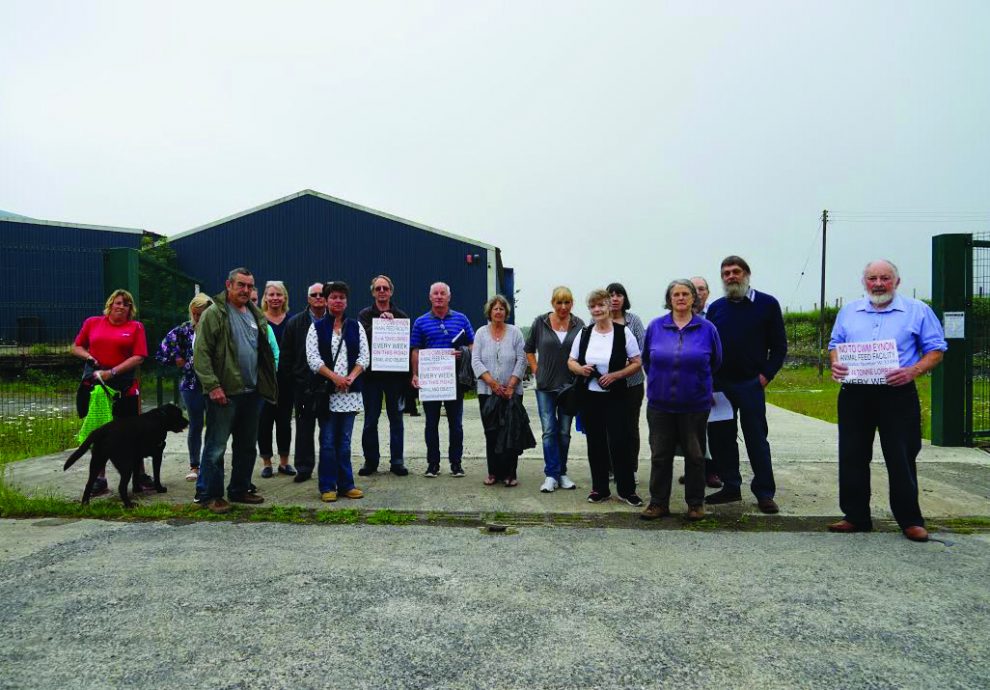 A PLANNING application for an animal feed store and access route near Four Roads was granted after the developer agreed to move the proposed access route away from the village square.
A PLANNING application for an animal feed store and access route near Four Roads was granted after the developer agreed to move the proposed access route away from the village square.
However, there was still strong local opposition to the development from residents, backed up by the community council.
Following a site visit by the Planning Committee on Tuesday (Jun 7) the application was discussed in a meeting that day.
Planning Officer John Thomas introduced the report, noting that two further letters of objection had been received, in addition to the 41 mentioned in the report. One of these was from local AM Adam Price.
The application was for planning permission for the change of use of the 5,500m2 agricultural buildings on the site to form a commercial animal feed storage, mixing and distribution centre.
It was proposed that the feed would be delivered using 29 tonne articulated lorries and delivered out to farms in 19 and 29 tonne lorries. A degree of direct sale and customer pick up was also expected – something an objector to the plans later commented on.
The traffic plan stated that seven large articulated lorries and eight smaller eight wheel lorries would travel to and from the site every day, along with two third party HGVs and three employee vehicles.
Mr Thomas pointed out that as a result of concerns raised over the previous application, which was withdrawn at the end of last year, a new access road from the C2057, crossing the C2204, was proposed, and that following the matter being discussed by the planning committee this track had been realigned to provide better visibility.
In terms of the objections, Mr Thomas said that they related to a range of issues, including damage to roads caused by increased HGV traffic, doubt over whether the creation of three full-time jobs warranted the increased noise and environmental pollution, and damage to property.
It was also suggested that an industrial estate would be a more suitable location for a business of this scale.
However, Mr Thomas said that the buildings, which date back to the 80s, had a history of unauthorised use under the previous owner, and that a change of use for the currently redundant building was covered by rural diversification guidelines.
In terms of the access, he pointed out that the new main road junction had clear visibility, and was in a 40mph zone, which will also be subject to further traffic calming measures in the next financial year.
Mr Thomas also claimed that road signage would be used to stop HGVs using any other route to access the site.
“It is worth noting that if planning is not granted, the site could be used for intensive agricultural purposes, which will generate increased HGV traffic,” he added.
Objecting to the plans, local resident Andrew Stevens said that Four Roads was ‘a small rural community’ and argued that the development and the existing building were out of scale for the village.
“It is not the right place to bring 44 ton vehicles just because weak planning history has left us with this huge building on our doorstep,” he added.
Mr Stevens also questioned the visibility from the road junction, and claimed that producing feed on the site would involve rolling and mixing of grains on site.
The agent for the applicant, Osian Roberts, on the other hand, concentrated on the jobs being created and claimed that the buildings were not suited for current agricultural use.
However, he added that they could be used for agricultural purposes should planning be refused, and that the operating restrictions of 7am-7pm would not apply if this happened.
Mr Roberts also said that he was disappointed with the community council, which he claimed had said would approve the application if the road was moved, and had not done so.
Local County Councillor Tyssul Evans, a member of the Planning Committee, reiterated that he had not commented on this matter when it was raised at a community council meeting, to keep the right to express his views in this meeting.
Cllr Evans said that had the original access route still been part of the plan, he would have voted against the application. However, ‘thankfully the applicant has seen sense,’ he added, remarking that the new road was ‘a great improvement’ on the original plan.
Stating that ‘the strengths of this application outweigh the shortcomings,’ Cllr Evans pointed out that creating half a dozen jobs ‘is the equivalent of hundreds in our larger towns’.
“I could go on and on about the grave need to keep the countryside alive,” he added, and claimed that he had received far more support than objection for the plan from ‘the silent majority’.
However, Heddwyn Jones, representing the community council, said there were ‘many technical reasons’ why the application should be refused, and mentioned the large numbers of letters sent to the council opposing the development. “Local residents are concerned that their letters are not given serious consideration by officers,” he added.
“This is not a language issue, this is not about culture, this is not inmigrants against a local farmer – this is residents who are concerned about the impact on their daily life.”
Cllr Jones also said that the lorries would create noise, dust and smells until late at night, and ‘could endanger lives.’
“Lorries will be certain to use the minor road past the chapel no matter how many signs the council erect,” he added.
Concerns were raised by Cllrs Winston Lemon and Kevin Madge about a culvert, and Cllr Madge also asked for reassurances that the traffic calming work would go ahead, querying whether the developer would contribute to the cost of this. He also suggested that the operational hours of the site should be changed from 7am – 6pm on weekdays.
Cllr Tom Theophilus said that while the building was ‘very large’ the committee should remember that it was originally built for another purpose, and he was glad that the applicant had chosen to make use of the building. He added that a similar operation near Llandovery had caused no problems with noise or smell.
Responding to Cllr Madge Cllr Evans pointed out that the traffic calming plans had been ‘in the pipeline’ for around 15 years.
Mr Thomas agreed, telling the committee that the plans had been recommended for approval with the existing speed limit in place. He added that because the traffic calming plans had been in place for some time, the developer would not be asked to contribute.
Cllr Madge’s fears that the traffic calming measures might not go ahead if Britain left the EU were considered to be ‘diverging from the point’ by the Chair of the Planning Committee Cllr Alun Lenny.
However, Cllr Lenny asked whether signs advising HGV drivers that certain roads were unsuitable and not to follow their sat-navs were legally enforceable, and was told that they were ‘advisory’.
The decision was unanimously approved, which appeared to anger at least one member of the public who shouted ‘corruption’ from the gallery.
Speaking after the meeting, Cllr Lenny said: “This was a case of rural regeneration conflicting with the concerns of local residents. Members were not happy with the original plan, which would have meant lorries having to turn on the crossroads in the centre of Four Roads village.
“The developer then submitted a revised application, which included constructing a new access road. This would impact much less on people living in Four Roads. Having visited the site and thoroughly scrutinised the highway factors, the committee agreed that on balance the development was acceptable.”
“Local residents felt very strongly about this, and I appreciate their disappointment at the decision. But I think that one objector’s repeated shouts of ‘corruption’ on leaving the public gallery was disgraceful – totally out of order.
“The democratic process was followed in full. People who make such wild accusations should be ready to substantiate them.”


















Add Comment